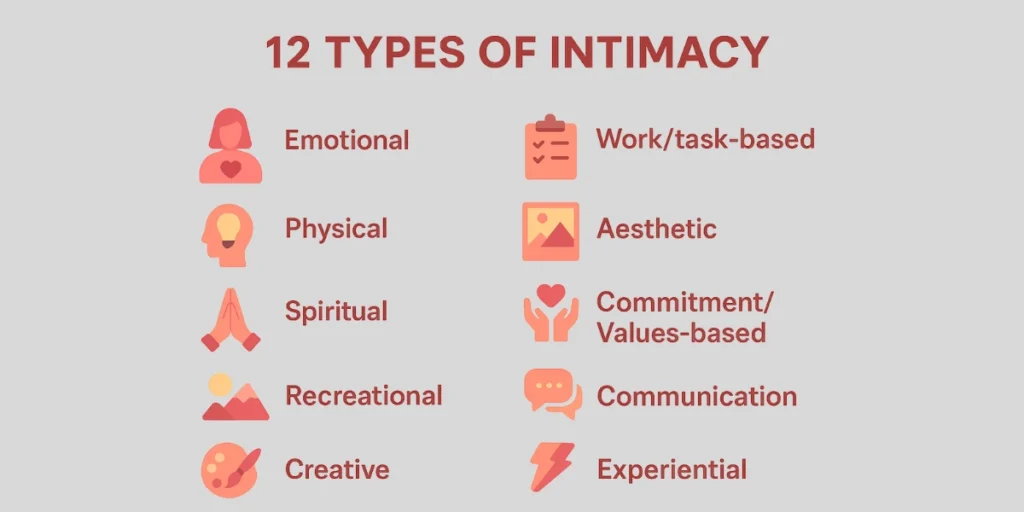12 Types of Intimacy: Deepening Connection & Closeness in Relationships.
Introduction
Intimacy goes far beyond merely sexual acts — it is foundational for emotional health, relationship satisfaction, and long-term well-being. Whether you are in a romantic partnership, friendship, or family relationship, understanding intimacy can help you feel more connected, understood, and loved.
In this insights, we will explore 12 types of intimacy, discuss the 5 levels of intimacy, common barriers, physical intimacy without sex, how to talk about intimacy with your partner, romance versus intimacy.
1.What Is Intimacy?
At its core, intimacy refers to closeness, trust, vulnerability, and the mutual sharing of one’s inner world. It is a dynamic process and not a fixed state. Intimacy involves multiple dimensions: emotional sharing, physical closeness, intellectual engagement, spiritual connection, and more.
👉 “If you want to assess how emotionally and physically connected you are with your partner, try our free Couple Intimacy Compatibility Calculator.”
2.The 12 Types of Intimacy
Based on psychology and relational wellness literature, here are 12 different types of intimacy often found in healthy relationships:
- Emotional Intimacy — sharing feelings, fears, hopes; being honest and vulnerable.
- Physical / Sexual Intimacy — sexual connection, but also non-sexual touch: hugging, cuddling, holding hands.
- Intellectual Intimacy — exchanging ideas, discussing beliefs, sharing thoughts about big topics.
- Spiritual Intimacy — sharing beliefs, meaning, purpose, or values that transcend daily life.
- Recreational / Experiential Intimacy — doing activities together, enjoying shared hobbies, exploring life together.
- Creative Intimacy — collaborating creatively, expressing yourselves together (art, writing, music); growing together through creative energy.
- Work / Task Intimacy — sharing responsibilities, collaborating on day-to-day tasks, planning life together.
- Aesthetic Intimacy — experiencing beauty together: nature, art, music; appreciating beauty with someone else.
- Commitment Intimacy — shared long-term goals, trust, loyalty, choosing each other over time. (
- Communication Intimacy — open, honest dialogue, sharing thoughts and listening with empathy.
- Conflict / Crisis Intimacy — ability to handle conflict, support during hard times, grow stronger through adversity.
- Spiritual / Meaning-Making Intimacy (or can be “Shared Values / Beliefs”) — aligning on what matters most, ethics, purpose, life meaning.
3. 5 Levels of Intimacy
To understand how close you are in a relationship, many therapists define 5 levels of intimacy. These help in mapping where your relationship currently is and where you want it to go.
| Level | Description |
| 1. Physical (Non-Sexual) | Touch, hugging, handholding, affectionate gestures without sexual intent. |
| 2. Emotional | Sharing inner feelings & vulnerabilities, developing trust. |
| 3. Intellectual | Sharing ideas, thoughts, discussing meaningful topics. |
| 4. Spiritual / Values | Shared spiritual beliefs, core values, meaning of life. |
| 5. Sexual / Romantic | Sexual connection + romance, passion, desire, mutual pleasure. |
4.Barriers to Intimacy
Even with good intentions, many relationships face obstacles. Common barriers include:
- Fear of vulnerability or rejection
- Past trauma or emotional wounds
- Poor communication habits
- Mismatched expectations of intimacy or love languages
- Physical or emotional distance, life stress, busy schedules
- Cultural or religious beliefs that restrict open expression
5.Physical Intimacy Without Sex
Not all physical intimacy requires sexual activity. Ways include:
- Hugging, cuddling, holding hands
- Sleeping together (non-sexual touch)
- Massage, gentle touch, comforting presence
- Kissing or caressing without pursuing intercourse
These forms of physical intimacy often strengthen emotional bonds and trust.
6.Ways to Be Intimate Without Sex
Intimacy is multifaceted. You can deepen connection without sexual activity by:
- Sharing deep conversations (emotional + intellectual)
- Engaging in shared activities & hobbies (recreational intimacy)
- Showing appreciation and mindfulness
- Practicing vulnerability, expressing fears or hopes
- Supporting each other in daily life & during hard times
7.Sexual Relationship & Intimacy
Sex can be a meaningful part of intimacy when it is safely shared, consensual, and respectful. Healthy sexual intimacy involves:
- Open communication about desires, boundaries
- Mutual consent, comfort, and pleasure
- Trust and safety
- Respecting each other’s emotional and physical needs
8.How to Talk to Your Partner About Intimacy
- Choose a calm, private time without distractions
- Use “I” statements (“I feel”, “I need”) rather than blame
- Be specific about what you desire (touch, words, time together)
- Listen without judgment; validate their feelings
- Recognize that intimacy needs change over time
9.What is Natural Intimacy
“Natural intimacy” refers to spontaneous expressions of closeness, not forced or scheduled. It includes:
- Warm gestures: holding hands, random hugs
- Genuine compliments & affectionate words
- Small rituals: morning routines, bedtime closeness
- Shared laughter, playfulness
These natural moments can reinforce bonds deeply.
10.Romance vs Intimacy
Although often mixed up, romance and intimacy are distinct:
- Romance involves gestures intended to invoke feeling of love: flowers, date nights, grand gestures.
- Intimacy is deeper and more consistent: vulnerability, trust, emotional presence, true knowing.
A romantic act can spark intimacy but intimate connection sustains love long-term.
11.Emotion in Relationship
Emotion is central. Key points:
- Emotional intelligence helps partners understand and express feelings.
- Sharing emotions (joy, fear, sadness) builds closeness.
- Suppressed emotions lead to distance or resentment.
- Regular emotional check-ins, empathy, validation are essential.
12.Sexual Hugging
“Hugging” has special value even in romantic or sexual relationships:
- When done sexually (but not necessarily intercourse), it deepens physical connection.
- It can release oxytocin (“bonding hormone”) even without sexual intercourse.
- Good for reducing stress, increasing feelings of safety.
Conclusion
Intimacy is not a one-dimensional concept. True relational health involves weaving together many types of intimacy—emotional, physical, intellectual, spiritual, experiential, creative—and navigating the five levels thoughtfully. While barriers exist, open communication, vulnerability, and mutual respect allow intimacy to grow. Whether you’re building a new relationship or deepening a longstanding one, prioritizing intimacy in all its forms leads to richer, more fulfilling connection.
FAQs
Q1: What are the 12 types of intimacy in a relationship?
The 12 types of intimacy include emotional, physical, sexual, intellectual, recreational, spiritual, experiential, creative, communication, crisis, financial, and commitment intimacy.
Q2: Which of the 12 types of intimacy are considered the healthiest?
Healthy intimacy types are those built on trust, consent, openness, and mutual respect—especially emotional, intellectual, and physical (non-sexual & sexual) intimacy.
Q3: Can the 12 types of intimacy exist without sexual intimacy?
Yes. Many of the 12 types of intimacy, such as emotional, intellectual, recreational, and spiritual intimacy, can exist without sexual intimacy.
Q4: In the 12 types of intimacy, what level usually comes first?
Often, relationships start with physical non-sexual or emotional intimacy, then deepen into intellectual, spiritual, or sexual intimacy as trust builds.
Q5: How do I know if one or more of the 12 types of intimacy are missing in my relationship?
Signs include feeling lonely, lack of closeness, avoiding deep conversations, feeling unseen, or disconnect in physical or emotional intimacy.
Q6: Are the 12 types of intimacy equally important in every relationship?
Not always. Some couples may focus more on emotional and physical intimacy, while others prioritize spiritual or financial intimacy. Balance is key.
Q7: What role do the 12 types of intimacy play in long-term relationships?
When all 12 types of intimacy are nurtured, couples experience stronger trust, deeper love, and better conflict resolution.
Q8: How can couples strengthen the 12 types of intimacy together?
By practicing open communication, spending quality time, being supportive in crises, and showing affection, partners can grow all 12 types of intimacy.
References
- American Psychological Association (APA) – Intimacy and Relationships
https://www.apa.org/topics/relationships/intimacy - John Gottman Institute – Building Emotional and Physical Intimacy
https://www.gottman.com/blog - National Institute of Mental Health (NIMH) – Relationships and Mental Health
https://www.nimh.nih.gov/health/topics - Harvard Health Publishing – Emotional Connection and Health Benefits
https://www.health.harvard.edu/mind-and-mood/the-health-benefits-of-emotional-intimacy - Journal of Social and Personal Relationships – Dimensions of Intimacy in Romantic Partnerships
https://journals.sagepub.com/home/spr - Mayo Clinic – Relationship Health and Intimacy
https://www.mayoclinic.org/healthy-lifestyle/adult-health/in-depth/relationships/art-20044949 - Psychology Today – Types of Intimacy and Relationship Satisfaction
https://www.psychologytoday.com/us/basics/intimacy - Cleveland Clinic – Emotional and Physical Closeness in Relationships
https://my.clevelandclinic.org/health/articles/22093-intimacy-in-relationships - American Psychiatric Association – Communication, Vulnerability, and Connection
https://www.psychiatry.org/patients-families/relationships - World Health Organization (WHO) – Social Relationships and Mental Health
https://www.who.int/news-room/fact-sheets/detail/mental-health-strengthening-our-response - Journal of Sex & Marital Therapy – Physical and Sexual Intimacy in Couples
https://www.tandfonline.com/toc/usmt20/current - National Health Service (NHS UK) – Emotional Closeness and Communication
https://www.nhs.uk/mental-health/advice-for-life-situations/relationships - American Family Therapy Academy (AFTA) – Therapy and Intimacy Enhancement
https://www.afta.org/ - PsychCentral – Overcoming Barriers to Intimacy
https://psychcentral.com/relationships - Verywell Mind – Understanding Emotional and Intellectual Intimacy
https://www.verywellmind.com/what-is-intimacy-2795334



